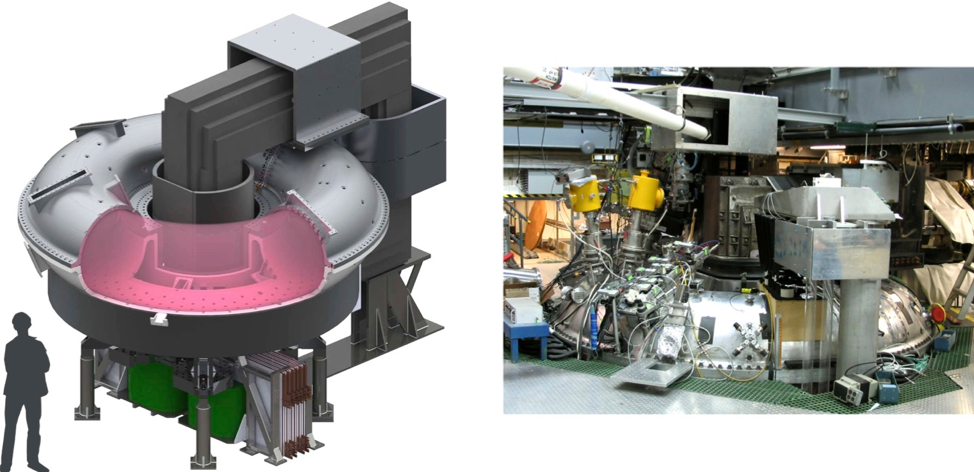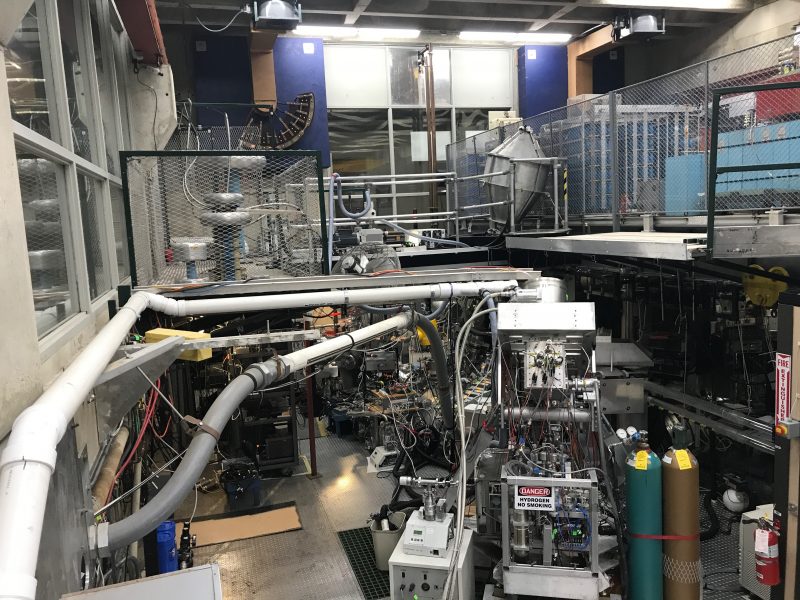The Madison Symmetric Torus (MST) produces toroidal plasmas, typically in either reversed field pinch (RFP) or low-safety-factor tokamak geometries. The RFP plasma represents a system in itself that simultaneously exhibits features of the frontier plasma science processes of reconnection, turbulence, particle energization, dynamo and coherent structure formation. It can also provide a fusion grade high temperature plasma with confinement times similar to a comparable-sized tokamak. The MST device gives users access to a well characterized toroidal plasma with a comprehensive suite of diagnostics.
Typical electron densities range from 0.5 – 1.5 x1019 m-3 with electron temperatures ranging between 200 – 1800 eV depending on discharge type. Discharges are typically 30 – 60 ms long with about 3 minutes between discharges. Typically over 100 shots are taken each day during a 4-day run week.
The construction of MST is unique in having an aluminum shell which serves as both the vacuum vessel as well as the equilibrium magnet (minor and major plasma radii, a=0.5 m and R=1.5 m). The poloidal field is created by a wide range of plasma current (30-500 kA) driven inductively. Ohmic heating of up to 10 MW is provided by the dissipation of the plasma current. An externally applied toroidal field of up to 0.3T is produced by the one-turn current in the shell.
Plasmas are typically fueled with deuterium using gas puff injection, but various gas species are available including hydrogen and helium. A separate gas puff injector is available to inject noble gasses like helium and argon. Plasma interaction with the limiters, tiles, and vessel wall introduce minority species including carbon, boron, oxygen, nitrogen, and aluminum.
Key parameters achieved in MST’s base operation are ρi ∼ ρs ≈ 0.2-5cm, Lundquist number S ~ 104-7 (based on equilibrium B), plasma flow 0-20 km/s (self-generated) to 50 km/s (biased electrode) with sonic Mach number Ms ∼ 0.5 and Alfvenic Mach number MA ∼ 0.1. The addition of external plasma sources like compact torus (CT) injection will be able to significantly alter these parameters.
This is an accordion element with a series of buttons that open and close related content panels.
Plasma Control Systems
The MST has a world-class set of advanced plasma diagnostics and plasma control capabilities that were developed as part of the RFP proof-of-principle program.
Pulsed Parallel Current Drive
PPCD is a current profile control technique used to suppress the development of resonant tearing modes in reversed field pinch plasmas. The energy confinement time increases an order of magnitude to 10-15 msec, electron temperatures reach 1-2 keV, and ion temperatures can reach 1 keV (depending on startup conditions). In these discharges, the transport mechanisms are no longer due to field line stochasticity as in standard RFP discharges. Due to the weak toroidal magnetic field, effects due to toroidicity are weaker leading to ion banana orbits on the order of the ion gyro radius. Ion transport tends to be dominated by classical transport in the core. The density gradient in the edge grows steep enough to destabilize drift-waves through the trapped electron mode instability.
Programmable Power Supplies
MST has new, high-current programmable power supplies to control the plasma current and toroidal field work supported by the National Science Foundation . These systems greatly increase the range of achievable dimensionless plasma parameters.
High-power neutral beam injector
A 1 MW high-power neutral beam injector produces a significant population of fast ions. Either hydrogen or deuterium neutrals can be injected tangentially into the plasma to create a significant population of fast ions in the core. This injection results in heating, increased rotation, fusion neutron and gamma production, and the stimulation of energetic particle instabilities.
Resonant Magnetic Perturbations
There is also a feedback-controlled saddle coil system that allows application of resonant and non-resonant magnetic perturbations, which affect magnetic reconnection and plasma flow. The system is used to lock helical plasmas into arbitrary orientations to enable study using optical, x-ray, and beam-based diagnostics.
Diagnostics
The MST has a world-class set of advanced plasma diagnostics and plasma control capabilities that were developed as part of the RFP proof-of-principle program.
Thomson Scattering
The multipoint Thomson scattering diagnostic provides 21 spatial point measurements of electron temperature across the minor radius. Thirty full electron temperature profiles can be obtained during each MST discharge, with a variable delay between each profile. Typical operation uses the twin pulse-burst Nd:YAG lasers to provide a sampling rate of 2 – 25 kHz.
Charge Exchange Recombination Spectroscopy
A 50 kV diagnostic neutral beam is used to stimulate near-UV emission. A high-étentdu grating spectrometer with photomultiplier tube detectors provides CHERS measurements of impurity ion density, velocity, and temperature with a time resolution of 100 kHz. Both poloidal and toroidal views are available.
Motional Stark Effect
Neutral hydrogen emission from the same diagnostic neutral beam is used to measure the core magnetic field using spectral MSE. These measurements are typically used in constraining magnetic equilibrium calculations.
Soft-X-ray tomography
Four SXR cameras view 40 sight lines covering the poloidal plane. Each sight line incorporates two-color measurements of the x-ray brightness which is used for tomographic reconstruction of the electron temperature profile and as a magnetic equilibrium constraint. Measurements of the absolute brightness, when combined with separate measurements of electron temperature and density and impurity content, provide sufficient information to determine the ion effective charge profile.
Fast X-ray Detector
The FXR detector is a high time resolution soft x-ray spectrometer that measures electron energization via emitted bremsstrahlung. The detector is a 10 mm2 silicon avalanche photodiode. The detector output is input to a Gaussian shaping amplifier with 20 ns shaping time and digitized at 500 MHz.
X-ray spectroscopy
Twleve hard x-ray detectors with 2 keV resolution and six soft x-ray detectors with 0.45 keV resolution can be installed on 17 possible chords viewing a poloidal plane. Photon detection uses pulse height analysis using 2.4 microsecond or 240 nanosecond shaping times and are digitized at 100 Mhz with a typical time resolution of up to 1 kHz. The detectors are used to preform X-ray spectroscopy to determine the characteristics of fast electron populations that develop during reconnection events.
Neutron detectors
Injection of fast deuterium ions and the natural acceleration of deuterium ions from reconnection events lead to D-D fusion reactions that produce a measurable neutron flux of 10^10 ??“ 10^11 n/s/m^2. A scintillator-photomultiplier system is used to measure the global neutron rate.
Advanced Neutral Particle Analyzer
The ANPA is capable of simultaneously measuring the hydrogen and deuterium fast neutrals that are created when fast ions injected by the 1 MW neutral beam undergo charge exchange with thermal ions. The ANPA can measure fast neutral energies between 25 – 50 keV with a time resolution of 10 microseconds.
Probes
Although limited to low-current discharges, various insertable probes are available including Langmuir probes for edge density and temperature measurements, capacitive probes to measure the radial profile of the plasma potential, and armored magnetic probes that enable insertion of a dense array of b-dot cubes to about the half-radius of the torus.
Collaborative diagnostics
Interferometry-polarimetry
The Far-Infrared (FIR) interferometer-polarimeter system, developed in collaboration with UCLA, offers fast-time response, high-resolution fluctuation measurements. The heterodyne detection system provides high bandwidth (up to ∼1 MHz) for measurement of dynamic changes in plasma equilibrium as well as high-frequency fluctuations in the chord-integrated electron density and Faraday rotation angle.
Heavy Ion Beam Probe
A heavy ion beam probe (HIBP), developed by Xantho Technologies, LLC, injects a beam of singly charged ions into the plasma. These primary ions are ionized to a higher charge state by electron impact resulting in a secondary population of doubly charged ions which are separated from the primary ions by the internal magnetic field of the plasma. Detection of the flux of secondary ions gives information on the core plasma potential, potential fluctuations, and electron density fluctuations.
Multi-Energy Soft X-Ray camera
A Pilatus 3 soft-xray camera, on loan from Princeton Plasma Physics Laboratory, is currently installed on a radial view of the torus. The pin-hole camera design enables 487 lines of sight across the poloidal cross section. Each pixel provides a digitally programmable energy threshold for creating a diagnostic sensitive to multiple x-ray ranges. The current operational scheme uses increments as low as 200 eV to cover energy thresholds between 2 – 20 keV. The camera has a 1 msec integration time and a 1 msec readout time for a 500 Hz frame rate.

